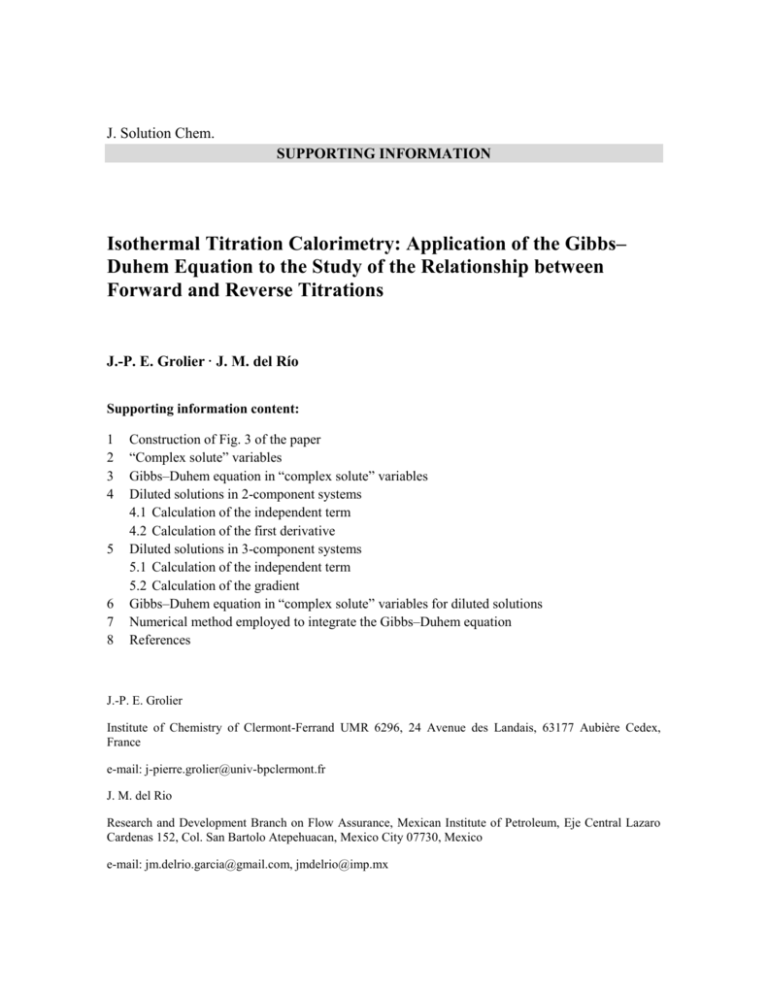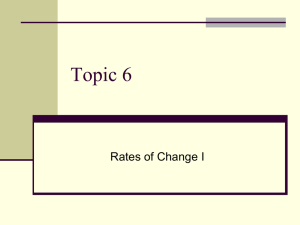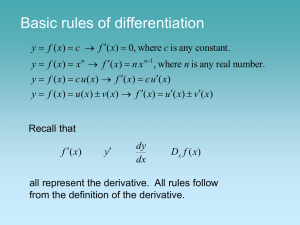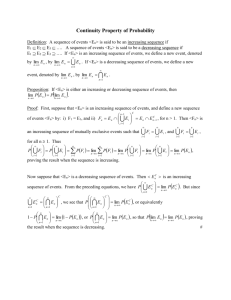3 Gibbs–Duhem Equation in “Complex Solute” Variables
advertisement

J. Solution Chem.
SUPPORTING INFORMATION
Isothermal Titration Calorimetry: Application of the Gibbs–
Duhem Equation to the Study of the Relationship between
Forward and Reverse Titrations
J.-P. E. Grolier · J. M. del Río
Supporting information content:
1
2
3
4
5
6
7
8
Construction of Fig. 3 of the paper
“Complex solute” variables
Gibbs–Duhem equation in “complex solute” variables
Diluted solutions in 2-component systems
4.1 Calculation of the independent term
4.2 Calculation of the first derivative
Diluted solutions in 3-component systems
5.1 Calculation of the independent term
5.2 Calculation of the gradient
Gibbs–Duhem equation in “complex solute” variables for diluted solutions
Numerical method employed to integrate the Gibbs–Duhem equation
References
J.-P. E. Grolier
Institute of Chemistry of Clermont-Ferrand UMR 6296, 24 Avenue des Landais, 63177 Aubière Cedex,
France
e-mail: j-pierre.grolier@univ-bpclermont.fr
J. M. del Rio
Research and Development Branch on Flow Assurance, Mexican Institute of Petroleum, Eje Central Lazaro
Cardenas 152, Col. San Bartolo Atepehuacan, Mexico City 07730, Mexico
e-mail: jm.delrio.garcia@gmail.com, jmdelrio@imp.mx
Isothermal Titration Calorimetry:
Application of the Gibbs-Duhem equation to the study of the forward and reverse titrations
1- Construction of Fig. 3 of the Paper
Insert A of Fig. 1 shows the excess enthalpy of the binary liquid mixture water + ethanol at different
temperatures. Data were taken from the literature [1].
2.7
0.6
3
B
-0.3
-0.6
A
0.00
0.25
0.50
0.75
1.00
0
hE2;1 (kJ/mol)
hE (kJ/mol)
0.0
hE1;2 (kJ/mol)
1.8
0.3
0.9
0.0
-0.9
-1.8
0.00
x2
0.25
0.50
0.75
1.00
-3
C
-6
-9
x1
0.00
0.25
0.50
0.75
1.00
x2
Fig. 1: A) Excess molar enthalpy of the binary mixtures of water (component 1) with ethanol
(component 2) at several temperatures. Data were taken from the literature [1]. B) Partial
excess molar enthalpy of the component water as function of its molar fraction. C) Partial
excess molar enthalpy of the component ethanol as function of its molar fraction. Plotting
symbols: , 232.15 K; , 343.15 K; , 383.15 K
Points shown in Insert A are experimental data and the solid curves are polynomial fitting
functions:
m
H = x2 (1- x2 )å ai x2i
E
(S1)
i=0
where x2 is the molar fraction of ethanol, the ai are coefficients that depend on temperature, and i
takes the values 0, 1/2, 3/2, 5/2 and 7/2. Insert B of Fig. 1 shows the excess partial molar enthalpy
E
of component 1, h1,2
, calculated from HE by the following equation [2]:
E
h1,2
= H E + (1- x1 )
dH E
dx1
(S2)
Points of Insert B are experimental values calculated from data of Insert A using a numerical
method to calculate the derivative dHE/dx2. The solid curves were calculated from Eq. 1.
Supporting Information
Page 2
J.-P. E. Grolier, J. M. del Río
Journal of Solution Chemistry
Insert C of Fig. 2 shows the excess partial molar enthalpy at different temperatures of
ethanol (component 2) which were calculated from data of Insert A by the equation [2]:
E
h2,1
= H E + (1- x2 )
dH E
dx 2
h E2;1 H E (1 x 2 )
dH E
dx 2
(S3)
Experimental points and solid curves in insert C were calculated in a similar way to those in insert
B.
2 “Complex Solute” Variables
We assume a 3-component system where component 1 is the solvent and components 2 and 3 are
solutes. The enthalpy H is written as:
H = H(n1, n2, n3 )
(S4)
where n1, n2 and n3 are, respectively, the number of moles of components 1, 2 and 3. In this system
the partial enthalpies of components 1, 2 and 3 are defined as:
h1,2,3 = (
¶H(n1, n2 , n3 )
)n2 ,n3
¶n1
(S5)
¶H(n1, n2 , n3 )
)n1,n3
¶n2
(S6)
¶H(n1, n2 , n3 )
)n1,n2
¶n3
(S7)
h2,1,3 = (
h3,1,2 = (
For a 2-compent systems the partial enthalpies h2,1 and h1,2 are defined in a similar way as in Eqs. 5–
7. For the variables n1, n2 and n3, and using the partial enthalpies (Eqs. 5–7), the differential of H
takes the form:
dH = h1,2,3dn1 + h2,1,3dn2 + h3,1,2 dn3
(S8)
If we consider the system as composed of a solvent (component 1) and a complex solute, S,
composed of components 2 and 3, then the enthalpy H can be written as
H = H(n1, nS, xs3 )
(S9)
where:
Page 3
Supporting Information
Isothermal Titration Calorimetry:
Application of the Gibbs-Duhem equation to the study of the forward and reverse titrations
nS = n1 + n2
(S10)
n3
n2 + n3
(S11)
xs3 =
In this case nS represents the number of moles of the complex solute and xs3 is a variable related to
its composition. From Eq. 9, dH takes the form:
dH = h1,Sdn1 + hS,1dnS + (
¶H
)n ,n dxs3
¶xs3 1 S
(S12)
where h1;S is the partial enthalpy of the solvent in the presence of the complex solute,
h1,3 (xS, xs3 ) = (
¶H(n1, nS, xs3 )
)nS,xs3
¶n1
(S13)
and hS;1 is the partial enthalpy of the complex solute in the solvent,
hS,1 (xS, xs3 ) = (
¶H(n1, nS, xs3 )
)n1,xs3 .
¶nS
(S14)
The variable xS represents the mole fraction of the complex solute.
From Eqs. 10 and 11 the change of variables can be written as:
n1 (n1, nS, xs3 ) = n1
(S15)
n2 (n1, nS, xs3 ) = (1- xs3 )nS
(S16)
n3 (n1, nS, xs3 ) = xs3nS
(S17)
Differentiating Eqs. 15 – 17, we obtain, respectively:
dn1 = dn1
¶n2
)xs3 dnS + ( ¶n2 )nS dxs3 = (1- xs3 )dnS - nSdxs3
¶nS
¶ns3
(S19)
¶n3
)xs3 dnS + ( ¶n3 )nS dxs3 = xs3dnS + nSdxs3
¶nS
¶ns3
(S20)
dn2 = (
dn3 = (
(S18)
Substituting Eqs. 18–20 into Eq. 8 and considering xs2 = 1 – xs3:
Supporting Information
Page 4
J.-P. E. Grolier, J. M. del Río
Journal of Solution Chemistry
dH = h1,2,3dn1 +(xs2h2,1,3 + xs3h3,1,2 )dnS +(h3,1,2 - h2,1,3 )dxs3
(S21)
Equating Eq. 12 to Eq. 21 and considering that n1, nS, and xs3 are independent variables we obtain
the following relations:
h1,S = h1,2,3
(S22)
hS,1 = xs2 h2,1,3 + xs3h3,1,2
(S23)
( ¶H )
(S24)
¶xS3
n1,nS
= nS (h3,1,2 - h2,1,3 )
3 Gibbs–Duhem Equation in “Complex Solute” Variables
The Euler´s equation for the enthalpy, expressed as a function of the complex solute (Eq. 9), is:
H = h1,Sn1 + hS,1nS
(S25)
The Gibbs–Duhem equation is obtained by differentiating Eq. 25, combining the result with Eqs. 12
and 24, and dividing by the total number of moles:
x1dh1,S + xSdhS,1 = xS (h3,2,1 - h2,1,3 )dxs3
(S26)
Considering now that h1;S and hS;1 are functions of xS and xs3:
dh1,S = (
¶h1,S
)xs3 dxS + (¶h1,S )xS dxs3
¶xS
¶xs3
(S27)
dhS,1 = (
¶hS,1
)xs3 dxS + (¶hS,1 )xS dxs3
¶xS
¶xs3
(S28)
and substituting Eqs. 27 and 28 in Eq. 26 and bearing in mind that xS and xs3 are independent
variables, the following equations are obtained:
x1 (
Page 5
¶h1,S
)xs3 + xS (¶hS,1 )xs3 = 0
¶xS
¶xS
(S29)
Supporting Information
Isothermal Titration Calorimetry:
Application of the Gibbs-Duhem equation to the study of the forward and reverse titrations
x1 (
¶h1,S
)xS + xS{(¶hS,1 )xS - (h3,1,2 - h2,1,3 )} = 0
¶xs3
¶xs3
(S30)
Differentiating in Eq. 23 with respect to xs3 and reorganizing:
(¶h )
S,1
¶xs3
xS
- (h3,1,2 - h2,1,3 ) = xs 2 (
¶h2,1,3
)xS + xs3 (¶h3,1,2 )xS
¶xs3
¶xs3
(S31)
and substituting the result in Eq. 30, the Gibbs–Duhem equation then takes the form:
x1 (
¶h1,S
)xs3 + xS (¶hS,1 )xs3 = 0
¶xS
¶xS
(S32)
x1 (
¶h1,S
)xS + xS[ xs2 (¶h2,1,3 )xS + xs3(¶h3,1,2 )xS ] = 0
¶xs3
¶xs3
¶xs3
(S33)
4 Diluted Solutions in 2-Component Systems
Experimentally it is easy to get a diluted solution: one only has to put more solvent in the solution.
Theoretically it is more difficult. This is because it is necessary to know the mathematical properties
that provide the characteristics of “diluted solution” in the thermodynamic partial properties. The
purpose of this section is to develop a mathematical framework in order to treat diluted solutions in
systems of two components.
It is an experimental fact that when a solute is removed from a solution, the behavior of the
solution approaches to the behavior of the solvent. This behavior allows the purification of
substances. In a 2-component system this fact can be expressed as:
limn2 ®0 H(n1, n2 ) = n1h1
(S34)
where h1 is the molar enthalpy of component 1 in its pure state. Considering Eq. 34 to be a
hypothesis, we will obtain, following Taylor´s expansion for the partial property of the solvent:
h1,2 (x2 ) = h1,2 (0) +
dh1,2 (0)
x2 +...
dx2
(S35)
that the independent term is:
h1,2 (0) = h1
Supporting Information
(S36)
Page 6
J.-P. E. Grolier, J. M. del Río
Journal of Solution Chemistry
and the following term is:
dh1,2 (0)
=0
dx2
(S37)
We will employ this fact to characterize a diluted solution and we will say that a solution is diluted
if:
h1,2 (x2 ) » h1
(S38)
In order to consider Eq. 38 as a thermodynamic fact when x2 is small enough, in what follows in this
section we will demonstrate Eqs. 36 and 37.
4.1 Calculation of the Independent Term
Equation 37 can be written as:
lim x2 ®0 h1,2 = h1
(S39)
and then, in this way:
lim x2 ®0 h1,2 (x2 ) = lim n2 ®0 (
¶H (n1, n2 )
)n2
¶n1
= lim n2 ®0[lim D®0
= lim D®0[lim n2 ®0
H (n1 + D, n2 ) - H (n2 , n2 )
]
D
H (n1 + D, n2 ) - H (n2 , n2 )
]
D
(S40)
Now applying Eq. 34 one gets:
h1 {n1 + D} - h1n1
]
D
hD
= lim D®0 ( 1 )
D
= h1
h1,2 (0) = lim D®0[
(S41)
4.2 Calculation of the First Derivative
Equation 37 will be written as:
Page 7
Supporting Information
Isothermal Titration Calorimetry:
Application of the Gibbs-Duhem equation to the study of the forward and reverse titrations
dh1,2 (0)
dh
= lim x2 ®0 ( 1,2 ) = 0
dx2
dx2
(S42)
In order to demonstrate Eq. 42, it is necessary to start with the Gibbs–Duhem equation for a 2component system:
x1 (
dh1,2
) + x2 ( dh2,1 ) = 0
dx2
dx2
(S43)
Taking the limits in Eq. 43 as x2 approaches zero:
lim x2 ®0 (
dh1,2
) + lim x2®0 ( dh2,1 ) = 0
dx2
dx2
(S44)
In this way, it can be demonstrated that Eq. 42 is equivalent to Eq. 44:
lim x2 ®0 (
dh2,1
)= 0
dx2
(S45)
It is easy to see Eq. 45 in the following way:
lim x2 ®0 x2 (
dh2,1
) = lim x2 ®0 x2[lim D®0 { x2,1 (x2 + D) - h2,1 (x2 )}]
dx2
D
x h (x + D) - x2 h2,1 (x2 )
= lim x2 ®0[lim D®0 { 2 2,1 2
}]
D
x h (x + D) - x2 h2,1 (x2 )
= lim D®0[ lim x2 ®0 { 2 2,1 2
}]
D
1
= lim D®0 ( ){lim x2 ®0 x2 h2,1 (x2 + D) - lim x2 ®0 x2 h2,1 (x2 )}
D
(S46)
First we can see that:
lim x2 ®0 x2 h2,1 (x2 ) = 0
(S47)
lim x2 ®0 x2 h2,1 (x2 ) = (lim x2 ®0 x2 )´{lim x2 ®0 h2,1 (x2 )}
(S48)
In effect,
Considering now that:
lim x2 ®0 x2 = lim n2 ®0 (
Supporting Information
n2
)
n1 + n2
(S49)
Page 8
J.-P. E. Grolier, J. M. del Río
Journal of Solution Chemistry
and that:
lim x2 ®0 h2,1 (x) = lim n2 ®0 (
H(n1, n ) - h1n1
),
n2
(S50)
Eq, 48 takes the form:
æ
n2 ö æ
H (n1 ,n2 ) - h1n1 ö
÷÷ ´ çç lim n ®0
÷÷
lim x ®0 x2 h2,1 (x2 ) = çç lim n ®0
2
2
2
n1 + n2 ø è
n2
è
ø
H (n1 ,n2 ) - h1n1
= lim n ®0{
}
2
n1 + n2
(S51)
Keeping in mind the hypothesis of Eq. 34, one gets:
lim x ®0 x2 h2,1 (x2 ) = lim n ®0{
2
2
=
H (n1 ,n2 ) - h1n1
}
n11 + n2
h1n1 - h1n1
n1
(S52)
=0
For the other limit in Eq. 46, we have:
(
) (
lim x ®0 x2h2;1 (x2 + D) = lim x ®0 x2 ´ lim x ®0 h2;1 (x2 + D)
2
2
2
)
= 0 ´ h2;1 (D)
(S53)
=0
because h2,1(Δ) < ∞. Substituting now Eqs. 52 and 53 into Eq. 46, then that:
lim x2 ®0 {x2 (
dh2,1
)} = lim D®0 ( 1 )(0 - 0)
dx2
D
(S54)
=0
and thus Eq. 37 is demonstrated.
5 Diluted Solutions in 3-Component Systems
When we have two solutes in solution, Eq. 34 can be generalized as:
lim n2 +n3®0 H(n1, n2, n3 ) = h1n1
Page 9
(S55)
Supporting Information
Isothermal Titration Calorimetry:
Application of the Gibbs-Duhem equation to the study of the forward and reverse titrations
Or, making a change of variables by using the “complex solute” variables,
limn ®0 H(n1,nS ,ns3 ) = h1n1
(S56)
S
The Taylor´s expansion of h1;S as function of the molar fraction of the complex solute (xS) and the
composition of the complex solute (xs3), around xS = 0, is:
é x
h1,S (xS , xs3 ) = h1,S (0, xs3 ) + Ñh1,S (0, xs3 )ê S
ê x
ë s3
ù
ú + ...
ú
û
(S57)
ææ
ö
¶h1,S (xS , xs3 ) ö æ ¶h1,S (xS , xs3 ) ö ÷
ç
ç
÷
ç
÷
Ñh1,S (xS , xs3 ) = ç
÷ ,ç
÷ ÷
çè
¶xS
¶xs3
øxs 3 è
øxS ø
è
(S58)
where h1,S(xS,xs3) is the gradient of h1,S defined as:
In this section we will demonstrate that:
h1,S (0, xs3 ) = h1
(S59)
Ñh1,S (0, xs3 ) = (0, 0)
(S60)
and that:
In this way, for diluted solutions, Eq. 57 takes the form:
h1,s (xS, xs3 ) » h1
(S61)
5.1 Calculation of the Independent Term
Equation 59 will be written in an equivalent form:
lim x ®0 h1,S = h1
(S62)
S
Then, Eq. 62 can be rewritten in the following way:
Supporting Information
Page 10
J.-P. E. Grolier, J. M. del Río
Journal of Solution Chemistry
æ ¶H (n ,n , x ) ö
1 S
s3
÷÷
lim x ®0 h1,S (xS , xs3 ) = lim n ®0 çç
S
S
¶n
è
ønS ,xs 3
1
é
H (n1 + D,nS , xs3 ) - H (n1 ,nS , xs3 ) ù
= lim n ®0 êlim D®0
ú
S
D
ë
û
é
H (n1 + D,nS , xs3 ) - H (n1 ,nS , xs3 ) ù
= lim D®0 êlim n ®0
ú
S
D
ë
û
(S63)
Introducing Eq. 56 into Eq. 63 we obtain:
im x ®0 h1;S (xS , xs3 ) = lim D®0
h1 éën1 + Dùû - h1n1
S
æhDö
= lim D®0 ç 1 ÷
è D ø
D
(S64)
= h1
5.2 Calculation of the First Partial Derivatives
The gradient at (0, xs3) is calculated considering that Eq. 60 can be written in the following way.
æ ¶h ö
lim x ®0 çç 1,S ÷÷ = 0
S
è ¶xs3 øxS
(S65)
æ ¶h ö
lim x ®0 çç 1,S ÷÷ = 0
S
è ¶xS øxs 3
(S66)
Then, Eq. 65 can be easily be rewritten as follows:
æ ¶h (x , x ) ö
é
h (x , x + D) - h1,S (xS , xs3 ) ù
ú
lim x ®0 çç 1,S S s3 ÷÷ = lim x ®0 êlim D®0 1,S S s3
S
S
¶xs3
D
êë
úû
è
øx S
é
h (x , x + D) - h1,S (xS , xs3 ) ù
ú
= lim D®0 êlim x ®0 1,S S s3
S
D
êë
úû
(S67)
and, using Eq. 62 we have:
lim x ®0 h1,S (xS , xs3 + D) = h1
(S68)
S
and then:
Page 11
Supporting Information
Isothermal Titration Calorimetry:
Application of the Gibbs-Duhem equation to the study of the forward and reverse titrations
æ ¶h (x , x ) ö
æh -h ö
lim x ®0 çç 1,S S s3 ÷÷ = lim D®0 ç 1 1 ÷
S
¶x s3
è D ø
è
øx S
æ0ö
= lim D®0 ç ÷
èDø
(S69)
=0
In order to demonstrate Eq. 66 we will consider the limit when xS approaches zero in Eq.
32:
æ ¶h ö
æ ¶h ö
lim x ®0 çç 1,S ÷÷ + lim x ®0 xS çç S,1 ÷÷ = 0
S
S
è ¶xS øxs 3
è ¶xS øxs 3
(S70)
In this way, to demonstrate Eq. 66 is equivalent to demonstrating that:
æ ¶h ö
lim x ®0 xS çç S,1 ÷÷ = 0
S
è ¶xS øxs 3
(S71)
In effect:
æ ¶h ö
é
h (x + D, xs3 ) - hS,1 (xS , xs3 ) ù
ú
lim x ®0 x S çç S,1 ÷÷ = lim x ®0 xS êlim D®0 S,1 S
S
S
D
êë
úû
è ¶x S øxs 3
é
x h (x + D, xs3 ) - xS hS,1 (xS , xs3 ) ù
ú
= lim x ®0 êlim D®0 S S,1 S
S
D
êë
úû
é
x h (x + D, xs3 ) - xS hS,1 (xS , xs3 ) ù
ú
= lim D®0 êlim x ®0 S S,1 S
S
D
êë
úû
= lim D®0
(S72)
1é
lim
x h (x + D, xs3 ) - lim x ®0 xShS,1 (xS , xs3 )ùû
S
D ë xS ®0 S S,1 S
Considering now that:
lim x ®0 xS = lim n ®0 (
S
S
nS
)
n1 + nS
(S73)
and that:
æ H (n ,n , x ) - h n ö
1 S
s3
1 1
÷÷
lim x ®0 hS,1 (xS , xs3 ) = lim n ®0 çç
S
S
n
è
ø
S
(S74)
Then, the term on xshS,1(xs,xs3) in the second member of the relation in brackets in Eq. 72 takes the
form:
Supporting Information
Page 12
J.-P. E. Grolier, J. M. del Río
Journal of Solution Chemistry
lim x ®0 xShS,1 (xS , xs3 ) = lim n ®0 (
S
S
= lim n ®0
S
nS
)( H (n1,nS , xs3 ) - h1n1 )
n1 + nS
nS
H (n1 ,nS , xs3 ) - h1n1
n1 + nS
(S75)
Taking into account Eq. 56:
æ H (n ,n , x ) - h n ö
1 S s3
1 1
÷÷
lim x ®0 xShS,1 (xS , xs3 ) = lim n ®0 çç
S
S
n
+
n
è
ø
1
S
æh n -h n ö
= çç 1 1 1 1 ÷÷
n1
è
ø
(S76)
=0
6 Gibbs–Duhem Equation for Diluted Solutions
Defining the partial enthalpy of interaction of the components 2 and 3 as:
Dh2,1,3 = h2,1,3 - h2,1
(S77)
Dh3,1,2 = h3,1,2 - h3,1
(S78)
é æ
æ ¶h ö
æ ¶Dh ö
æ ¶h ö
æ ¶h ö ù
¶Dh2,1,3 ö
3,1,2
÷÷ + xs3 çç
÷÷ + xs2 çç 2,1 ÷÷ + xs3 çç 3,1 ÷÷ ú = 0
x1 çç 1,S ÷÷ + xS ê xs2 çç
ê è ¶xs3 ø
è ¶xs3 øxS
è ¶xs3 øxS
è ¶xs3 øxS
è ¶xs3 øxS úû
xS
ë
(S79)
and using Eqs. 77 and 78 in Eq. 33 yields:
In Eq. 77, Δh2;1,3 and h2;1,3 are evaluated when using concentrations xS and xs3. Accordingly, h2,1 is
evaluated using the concentration x2 such that x2 = xSxs2 where xs2 = 1 – xs3. In this way:
æ
ö
ç dh
÷
æ ¶h ö
dh æ ¶x ö
ç
÷
çç 2,1 ÷÷ = 2,1 çç 2 ÷÷ = -xS ç 2, 1 ÷
ç
÷
¶x
dx
¶x
dx
ç
è s3 øx F
2 è
s3 ø x
2 ÷
F
è
ø
(S80)
Considering Eq. 80 and the Gibbs–Duhem equation for a 2-component system (Eq. 43), we obtain:
æ ¶h ö
æ dh ö
xs2 çç 2,1 ÷÷ = x1 çç 1,2 ÷÷
è ¶xs3 øxS
è dx2 ø
(S81)
In a similar way, for the component 3:
Page 13
Supporting Information
Isothermal Titration Calorimetry:
Application of the Gibbs-Duhem equation to the study of the forward and reverse titrations
(S82)
Substituting now Eqs. 81 and 82 into Eq. 79 we can write:
é æ
ù
æ ¶h ö
æ ¶Dh ö
æ dh
¶Dh2,1,3 ö
dh1,3 öú
1;S
3,1,2
1,2
ê
ç
÷
ç
÷
ç
÷
ç
÷
x1 ç
÷ + xS ê xs2 ç ¶x ÷ + xs3 ç ¶x ÷ + x1 ç dx + dx ÷ú = 0
è ¶xs3 øxS
è
è 2
s3 ø x
s3 ø x
3 øû
ë è
S
S
(S83)
Considering diluted solutions for 2-components systems (Eq. 38):
dh1,2
dx2
=
dh1,3
dx3
=0
(S84)
and for a 3-componet system (Eq. 61):
æ ¶h ö
çç 1,S ÷÷ = 0 ,
è ¶xs3 øxS
(S85)
the Gibbs–Duhem equation, Eq. 83 takes the following form after reorganization:
æ ¶Dh ö
æ ¶Dh ö
2,1,3
3,1,2
÷÷ + xs3 çç
÷÷ = 0
xs2 çç
¶x
¶x
è
è
s3 ø x
s3 ø x
S
S
(S86)
7 Numerical Method Employed to Integrate the Gibbs–Duhem
Equation
After integration, Eq. 86 takes the form:
xs 3
Dh2,1,3 (xs3 ) = - ò
0
¢ æ dDh3,1,2 ö
xs3
ç
÷ dx¢
¢ çè dxs3
¢ ÷ø s3
1- xs3
(S87)
In this section a numerical method employed to integrate Eq. 87 using experimental data is
developed.
Equation 87 can be written as:
Dh2,1,3 (xs3 ) =
xs 3
ò F( x¢ ) dx¢
s3
s3
(S88)
0
Supporting Information
Page 14
J.-P. E. Grolier, J. M. del Río
Journal of Solution Chemistry
where
F(xs3 ) = -
xs3 æ dDh3,1,2 (xs3 ) ö
ç
÷÷
1- xs3 çè
dxs3
ø
(S89)
and
D(xs3 ) =
dDh3,1,2 (xs3 )
(S90)
dxs3
We will suppose that experimental data of Δh3,1,2 as function of xs3 are available as in the
following table:
(1)
s3
x
Δh3;1,2
Δh3,1,2( xs3(1) )
(2)
xs3
Δh3,1,2( xs3(2) )
(3)
xs3
xs3(N -1)
Δh3,1,2( xs3(3) )
…
…
Δh3,1,2( xs3(i) )
…
…
Δh3,1,2( xs3(N -1) )
xs3(N )
Δh3,1,2( xs3(N ) )
xs3
…
…
xs3(i)
…
…
For the first point, D(xs3) is calculated as:
D(xs3(1) ) =
Dh3,1,2 (xs3(2) ) - Dh3,1,2 (xs3(1) )
(S91)
xs3(2) - xs3(1)
and for the following points until the point N – 1, D(xs3) will be calculated in the same way than for
the second one.
D(x ) =
(2)
s3
Dh3,1,2 (xs3(3) ) - Dh3,1,2 (xs3(1) )
(S92)
xs3(3) - xs3(1)
The next step is to calculate F(xs3) using Eq. 89. The first value of Δh2,1,3 was calculated as:
æ x (1) + x (2) ö
(1)
s3 ÷
Dh2,1,3 (xs3(1) ) = çç s3
÷ F(xs3 )
2
è
ø
Page 15
(S93)
Supporting Information
Isothermal Titration Calorimetry:
Application of the Gibbs-Duhem equation to the study of the forward and reverse titrations
The second value was calculated by:
æ x (2) + x (3) x (1) + x (2) ö
s3
Dh2,1,3 (xs3(2) ) = Dh2,1,3 (xs3(1) ) + çç s3
- s3 s3 ÷÷ F(xs3(2) )
2
2
è
ø
(S94)
æ x (3) + x (4) x (2) + x (3) ö
(3)
s3
s3 ÷
Dh2,1,3 (xs3(3) ) = Dh2,1,3 (xs3(2) ) + çç s3
- s3
÷ F(xs3 )
2
2
è
ø
(S95)
and third value by:
and continuing until the N – 1 point is calculated as in Eq. 95.
8 References
1. Larkin, J.A.: Thermodynamic properties of aqueous non-electrolyte mixtures I. Excess enthalpy
for water + ethanol at 298.15 K. J. Chem. Thermodyn. 7, 137–148 (1974)
2. Marsh, K.N., Stokes, R.H.: Enthalpies of mixing of n-hexane + cyclohexane at 25 °C. J. Chem.
Thermodyn. 1, 223–225 (1969)
Supporting Information
Page 16







